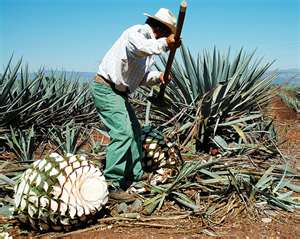Tequila is exclusively a product of Mexico. By law, it can be produced only in the state of Jalisco on Mexico’s west central coast, in limited regions of neighboring states of Nayarit, Michoacan, and Guanajuanto, and in Tamaulipas which borders on Texas and the Gulf of Mexico. Principal production takes place around the city of Tequila in Jalisco where red volcanic soil is particularly suited to growing the blue Weber agave plant. More than 300 million are harvested on plantations there each year.
The agave is a desert plant which takes 8-10 years to mature. Those grown in highland regions are larger in size, sweeter in aroma and taste, and thus produce sweeter and fruitier tequila. Agaves grown in the lowlands have a more herbaceous fragrance and aroma. Since the agave shortage in 1999-2000, producers use both highland and lowland plants. Tequila must be made with at least 51% blue agave otherwise it is known as mezcal. Fine tequilas are made of 100% blue agave.
When an agave is ready for harvesting, a Jimador manually cuts away leaves to extract the plant’s core or piña. A piña weighs between 65 and 135 pounds; about 17 pounds ae needed to make a liter of tequila. Piñas are cut up and either roasted in cooking ovens or steamed in large pressure cookers to turn starches into sugars. Then they are shredded and put through a press to squeeze juices from the pulp.
If the producer is making 100% agave tequila, the juice goes into a wooden or stainless steel fermentation tank where yeast is added. For “mixtos tequila” which is less than 100% agave, juice first goes into a formulation tank for addition of sugarcane juice, then goes on to fermentation. Each distillery has its own proprietary strains of yeast and techniques for using them. Depending on the amount of water and sugar in the piña, the type of yeast used, and the ambient temperature, juice takes between 12 hours and several days to ferment and produces liquid about 6% alcohol. Distilling fermented juice once produces a cloudy liquid used to make a variety of tequilas.
- Tequila blanco: The second distillation results in a clear liquid 50% alcohol which, when reduced to 40% by adding distilled water, is aged for up to two months and bottled as silver tequila.
- Tequila reposado: Aging in oak barrels between two months and a year produces golden-colored “tequila that has rested.” Used whiskey, bourbon, or wine barrels are obtained from the US, France, or Canada for this purpose and each imparts its own flavor during the aging process. Gold tequila is either silver tequila with caramel coloring or a mixture of silver and reposado tequilas.
- Tequila añejo: Barrel-aging between one and three years produces aged or vintage tequila.
- Tequila extra añejo: This extra-vintage tequila is aged beyond three years. Añejo tequilas are darker in color, have more complex flavors, and are increasingly expensive.
Currently there are more than 100 distilleries making more than 900 brands of Tequila in Mexico. All 100% agave tequila must be bottled in Mexico. Us liquor companies import bulk tequila that is less than 100% agave and bottle it according to an agreement with the Mexican government.
No tequila contains a worm in the bottle or ever did. Certain mezcals were sold in this fashion as a marketing gimmick in the late 1940s. The worm was the larval form of the moth Hypopta agavis which lives on the agave plant.
_______________
“One tequila, two tequila, three tequila, floor.” — George Carlin
“Tequila. Straight. There’s a real polite drink. You keep drinking until you finally take one more and it just won’t go down. Then you know you’ve reached your limit.” — Lee Marvin

